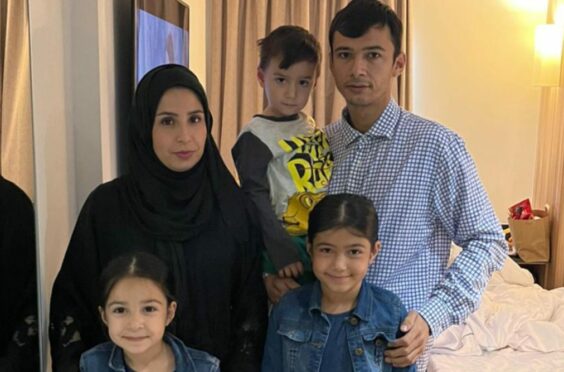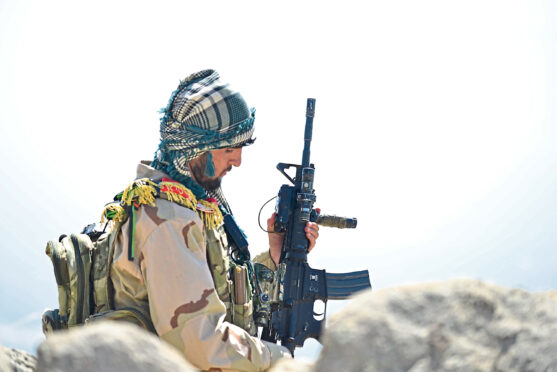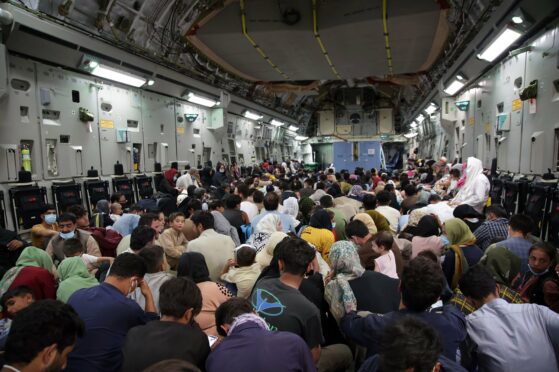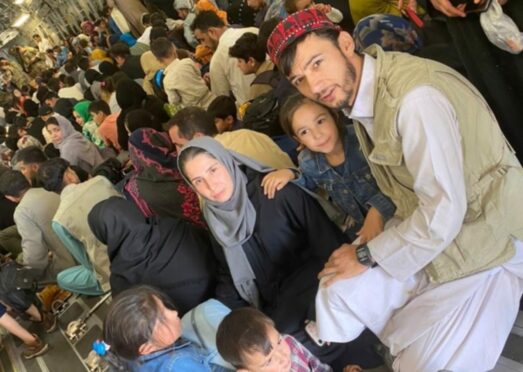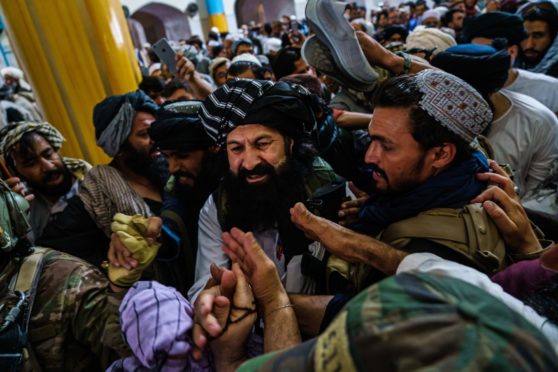
A US airstrike in Afghanistan yesterday killed two members of Islamic State group IS-K in retaliation for the suicide attack at Kabul airport.
The Pentagon said the two men were responsible for the bombing that killed more than 170 people, including 13 US troops. One other Islamic State target was also wounded in yesterday’s drone attack in the Nangahar province.
Pentagon spokesman John Kirby said at a briefing that the men killed were IS-K “planners and facilitators” of Thursday’s attack using a suicide vest containing 25lbs of explosives and loaded with shrapnel.
Asked whether this strike was retaliation for the suicide bombing at Kabul airport, he said: “It is not coincidence it happened just a couple of days after we lost 13 brave servicemen.”
The Taliban, however, said the US should have informed them before carrying out the airstrike. “It was a clear attack on Afghan territory. Two people were killed, two women and a child were wounded,” they said.
But Taliban officials have also said they would take “every measure” to capture those responsible for Thursday’s attack and have made IS-K leader Shahab al-Muhajir their number one target.
IS-K, or Islamic State Khorasan, is named after a former Islamic empire comprising parts of Afghanistan, Iran, Pakistan and Turkmenistan. IS-K believes the Taliban sold out to the US by making a deal with Donald Trump, and the two factions have been at war for three years. IS-K had 2,000 fighters but its numbers have been increased by a further 2,000 freed in prison breaks when the Taliban took control of Afghanistan.
Meanwhile, hundreds of Afghans protested outside a bank in Kabul and others formed long queues at cash machines yesterday, as a UN agency warned a worsening drought could leave millions of people in need of humanitarian aid. The protesters at New Kabul Bank included many civil servants demanding their salaries, which they said had not been paid for the past three to six months.
Yesterday afternoon the central bank ordered commercial branches to open and allow customers to withdraw £145 per week, calling it a temporary measure. Cash machines are still operating, but withdrawals are limited to £145 every 24 hours, causing long queues to form. The Taliban cannot access any of the Afghan central bank’s £6.5 billion in reserves, most of which is held by the New York Federal Reserve. The International Monetary Fund has also suspended the transfer of £327 million. Without a regular supply of US dollars, the local currency is at risk of collapse, which could send the price of basic goods soaring.
Economic crisis
An economic crisis could give Western nations leverage as they urge the Taliban to form a moderate, inclusive government and allow people to leave after the planned withdrawal of US forces on Tuesday. The UK Government has previously said the G7 nations should consider economic sanctions and withhold aid if the Taliban commits human rights abuses and allows Afghanistan to be used as a haven for terrorists.
But Rory Stewart, former secretary of state for international development and an expert in the region, said: “Afghanistan has been in the hands of the Taliban for 14 days now. We know that the West has lost whatever authority and leverage it retained by its abrupt withdrawal.
“The time to negotiate was when there were international troops on the ground, not after we have surrendered the country to the Taliban. Above all, we should not be imposing sanctions that will simply inflict even more damage on vulnerable Afghans while leaving the Taliban unaffected.”
The US and its allies have said they will continue providing humanitarian aid through the UN and other partners, but any broader engagement – including development assistance – is likely to hinge on whether the Taliban delivers on its promises of more moderate rule. When the Taliban last governed Afghanistan, from 1996 until the US-led invasion in 2001, it imposed a harsh interpretation of Islamic law.
Women were largely confined to their homes, television and music were banned, and criminals were executed in public.
Dr Gareth Price, senior research fellow in the Asia-Pacific Programme at Chatham House, said: “No one knows if the Taliban have changed or not. If they haven’t changed, Afghanistan could return to the pretty brutal place it was last time round. One of the ways the Taliban may have changed is that they do seem cognisant of the need to have an economy. That is why they are desperate for international recognition. Around 400,000 people were employed by the Afghan government, and most of their salaries came from western assistance, which has stopped now.
“If they are saying they want women to work, it’s partly because they want people to give them some money.
“The Taliban are also talking about banning opium production, which plays nicely internationally, but that puts a lot of people’s livelihoods under threat.
“The educated people were the interpreters, and they have all left. Afghanistan is going to be like Bangladesh after it gained its independence in 1971, when nearly all the middle class were wiped out. The people they need to build a country are either on planes to Qatar or heading for the Pakistan border.
“If the Taliban is now more moderate, they face the challenge of being outflanked on the right by Islamic State-type people saying they are not Islamic enough.
“Add all that together and you having Afghanistan being a pretty rough place over the next few years.”
Drought threat
Meanwhile, a UN agency has warned that a worsening drought threatens the livelihoods of more than seven million people.
The Food and Agriculture Organisation (FAO) said Afghans were also suffering from the coronavirus pandemic and displacement from the recent fighting.
Earlier this month, the United Nations World Food Programme estimated that some 14 million people – roughly one out of every three Afghans – urgently need food assistance.
The FAO said crucial help was needed ahead of the winter wheat planting season, which begins in a month in many areas.
So far, funding would cover assistance to only 110,000 families of farmers, while some 1.5 million need help, the agency said, adding that the current harvest is expected to be 20% below last year.

Enjoy the convenience of having The Sunday Post delivered as a digital ePaper straight to your smartphone, tablet or computer.
Subscribe for only £5.49 a month and enjoy all the benefits of the printed paper as a digital replica.
Subscribe
